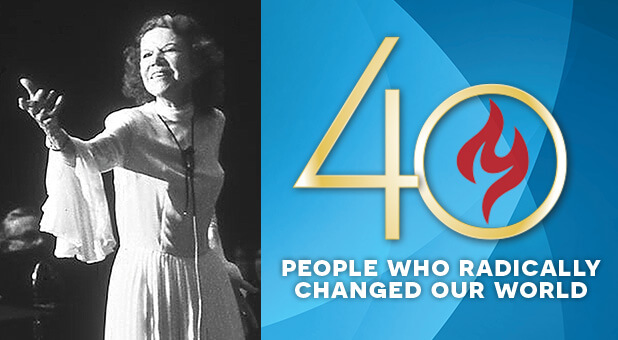One of the most noted female leaders in Pentecostalism, Kathryn Kuhlman died in 1976, shortly after appearing on the cover of Charisma’s second issue. Though widely heralded for her healing ministry, she insisted her primary purpose was the salvation of souls.
Known for her electric personality, unique style of dress and speaking in a deliberate voice, Kuhlman captivated audiences and frequently called out healings occurring in the auditorium. Long before the Toronto Revival, people were slain in the Spirit at her meetings, although she banned outbursts of tongues, dancing or prophecy.
The author of a series of best-selling books, in the 1960s and ’70s her weekly TV programs (I Believe in Miracles) aired nationwide and in Canada. Over the last 11 years of her life, she hosted monthly, typically packed services at the Shrine Auditorium in Pasadena, California.
Evangelist Benny Hinn openly acknowledges Kuhlman’s influence on him. Ralph Wilkerson—pastor of Southern California’s Melodyland Christian Center (demolished in 2003)—also patterned his ministry after her. “She was unique in her time period,” says Pentecostal historian Vinson Synan. “She was a woman minister at a time when most healing evangelists were men. She was a later version of (Foursquare founder) Aimee Semple McPherson, who influenced her.”
Born in Missouri to strict German parents, Kuhlman received Christ at age 14 at an evangelistic meeting in a Methodist church. Her born-again experience quickly led to ministry; two years later she convinced the elders of a small Baptist church to let her preach and filled the place.
Later ordained at the Evangelical Church Alliance in Joliet, Illinois, at one time she pastored a large church in Denver, although it closed during the Depression. In the 1940s she began traveling extensively to hold healing crusades, sparked by the testimony in 1946 of a woman who told of being healed of a tumor the previous night. That marked the first healing at one of her meetings and set the course for the rest of her ministry.
A favorable article in Redbook magazine in 1950 further propelled her ministry, which carried her across the world and led to a meeting with Pope John Paul XI in Rome. TIME magazine once called her a “one-woman Shrine of Lourdes.”
Synan says the Redbook article helped establish Kuhlman as a national figure. It also caused the public to take another look at divine healing, Kuhlman biographer Wayne Warner told Charisma in 1995. “Suddenly the gifts of the Spirit weren’t just for that little gospel mission on the other side of town,” Warner said. “They were for everybody.”
On her part, Kuhlman disclaimed any responsibility for healing, saying it originated with the power of God. In Charisma’s 1975 story, she spoke of an anointing that came over her on stage that was difficult to explain. “These things are supernatural,” she said. “That’s the reason it’s so hard for the natural mind to comprehend … I am completely taken over by the Holy Spirit—just completely.”
Kuhlman established the foundation that bears her name in 1954. At its peak, it had a staff of 30, funded her radio and TV ministry, and helped establish two dozen missions around the world. Today, the foundation has downsized to four employees. Yet Executive Director Carol Gray says the Pittsburgh-based group receives emails and letters from around the world with prayer requests and requests for books and DVDs. Gray attributes much activity to a budding interest in the work of the Holy Spirit, a topic covered extensively in a 1997 collection of Kuhlman’s sermons, The Greatest Power in the World. Last year the foundation released a DVD that included messages on the Rapture and the Second Coming.
Since healing came second to salvation in her ministry, the Kathryn Kuhlman Foundation still exists to reach as many people with the gospel as possible, its director says.
“We get testimonies today of people being filled with the Spirit and receiving salvation, so God is still using the ministry, for which we’re very grateful,” Gray says. Although with the passing of time fewer people are familiar with Kuhlman, Synan says she remains a model for female college students and ministers.
“When I was at ORU, students loved to see her videos,” says the retired Regent University professor. “I thank God I met her one time. I was impressed. It was rather remarkable and miraculous.” —Ken Walker












